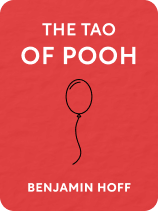

This article is an excerpt from the Shortform book guide to "The Tao of Pooh" by Benjamin Hoff. Shortform has the world's best summaries and analyses of books you should be reading.
Like this article? Sign up for a free trial here .
What is p’u? What does the Uncarved Block represent and how is this represented in The Tao of Pooh?
The Uncarved Block, or p’u, is a concept from Taoism. So, what is p’u representative of? It means that things in their original state carry their own natural power
Read on for the answer to “what is p’u?” and understand the concept of the Uncarved Block.
Simple Like an Uncarved Block
How can a loveable childhood character reveal the meaning of life? By living a simple life of doing nothing. In the Tao of Pooh, Benjamin Hoff reveals how the simple-minded character of Winnie the Pooh perfectly emulates the teachings of the ancient Chinese philosophy of Taoism. Taoist principles revolve around simply living as you are and following the natural power of the universe to find wisdom and happiness. While all the other creatures living in Pooh’s world get into all sorts of antics by overthinking or overacting, Pooh simply meanders as he is without question. The Way of Pooh is the Way of Taoism.
Principle 1 of Taoism: What Is P’u?
There are several principles that express the teachings of Taoism, which are exemplified in elements from Winnie-the-Pooh or The House at Pooh Corner. As we’ll see, the main antagonists to the Way of the Tao are knowledge and cleverness. These two characteristics are represented by Owl, Rabbit, and Eeyore and often get in the way of growth and wisdom.
The first is the Taoist concept of P’u (pronounced like Pooh). What is p’u? It says that things in their original state carry their own natural power. This concept is represented as the “Uncarved Block” and is a significant principle of Taoism. Pooh is the epitome of P’u because his simple-minded nature allows him to move through life and accomplish things without trying. He doesn’t know enough to question life or manipulate the world around him. His desires are simple; therefore, he lives simply.
So, what is p’u, and is the simplicity an insult? Being simple does not mean being stupid in Taoist culture. It means being wise, which is different from having knowledge or cleverness. The fact that Pooh is always the hero in his stories, rather than the more knowledgeable Owl, Rabbit, and Eeyore, is significant.
What Is P’u? An Example
What is p’u and how can you see it in Winnie-the-Pooh? An example from one of their adventures helps explain the difference:
One day, Rabbit, Pooh, and Piglet were lost in the woods. They followed many paths, but they always seemed to end up at the same sandpit. Rabbit, always on the lookout to show how smart he is, reasoned that the pit was a sign that he knew where they were in the woods. But Pooh thought the pit was following them. When it was time to find a new direction, Rabbit wracked his brain to determine the right direction, but Pooh suggested a different tactic. He thought they should try to find the sandpit.
Pooh’s reasoning was this: When they went looking for home, they always found the pit instead. If they started looking for the pit, they would surely not find it because they hadn’t found anything they’d been looking for all day. Instead of the pit, they might find another thing, and maybe the thing they find will be the thing they’re looking for. Using this strategy, they were able to make it out of the forest and find their way to Christopher Robin’s. Pooh and Piglet acknowledged that with all of Rabbit’s cleverness, he doesn’t really understand anything.
Pooh illustrates two principles of the Uncarved Block: 1) a willingness to be spontaneous and the ability to be successful in those spontaneous endeavors and 2) the state of accepting things for what they are.
For instance, Pooh and Piglet were sitting around deciding who to go visit one morning. Pooh suggested they visit everyone, but Piglet thought they should have a reason for visiting. Pooh came up with a reason—it was Thursday. They could simply go around wishing everyone a happy Thursday. Piglet had to admit that even though Pooh doesn’t have much Brain, things always turn out right for him.
The Problem with Knowledge
In the world of Pooh, Owl represents the Brain, or scholar. In Chinese culture, the scholar is the embodiment of knowledge and signifies the way of Confucianism. The scholar seeks knowledge simply for the sake of having it and guards it closely. The knowledge is disseminated to the general public using pretentious or overwrought language to create distance between the reader and the information. If we can’t understand what the scholar is saying, they can remain superior and unchallenged. The priority is to prove their own intelligence, not enlighten others.
But looking at life through the lens of academic dissertation is like getting to know someone by looking at their wax replica in a museum. Scholarship loses the spirit of life and often expresses things in a way that differs from lived experience, which makes the concepts more difficult to grasp. Knowledge and experience are not equal, and not everything can be named or identified by category or genus. There are many useful applications for the characteristics and activities of scholars, but there is more to life than what can be intellectually understood.
Taoists refer to the tendencies of scholars as an inability to see the good parts of life. In Taoism, “the wise are not learned, and the learned are not wise.” Intelligence is beneficial for analyzing certain aspects of life, but it is limited in understanding the deeper and grander meanings held within nature. The limitations of knowledge restrict the scholar’s scope of the world.
An example of the limitations of knowledge is expressed when Owl attempts to teach Pooh how to spell Tuesday. Musing that everybody knows that Tuesday is spelled Twosday because it falls on the second day of the week, Owl exclaims that the day after Twosday is Thirdsday. Owl uses logic based on a narrow scope of knowledge to come to the wrong conclusion, rather than accepting reality for what it is or seeking to understand what he cannot explain.
In the West, where Taoism is understood not through practice or from Taoist teachers, but from the likes of the Scholarly Owl, the principles are dissected, examined, and interpreted as definitions and origins. Western Taoist teachings are the wax statue of the holistic Taoist way of life.
Knowledge affects the Uncarved Block when it manipulates the natural Way of things. When you stop trying to cajole life into bits and pieces of useful information, the simple inherent power of the universe shines through. Pooh is lovable because of his simplicity. He has no ego, complexity, arrogance, or self-interest and sees life with childlike wonder. This is the essence of the Uncarved Block and when life becomes fun and joyous.

———End of Preview———
Like what you just read? Read the rest of the world's best book summary and analysis of Benjamin Hoff's "The Tao of Pooh" at Shortform .
Here's what you'll find in our full The Tao of Pooh summary :
- How Winnie-the-Pooh perfectly models the principles of Taoism
- The 6 principles of Taoism reflected in Pooh's adventures
- How to become Winnie-the-Pooh and unlock a magic inside of you






